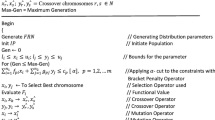Abstract
Bilevel linear programming problem is a special class of nonconvex optimization problems which involves two levels with a hierarchical organization structure. In this paper, we present a genetic algorithm (GA) based approach to solve the bilevel linear programming (BLP) problem. The efficiency of this approach is confirmed by comparing the results with Kuo and Han’s method HGAPSO consisting of a hybrid of GA and particle swarm optimization algorithm (PSO) in Kuo and Han (Applied Mathematical Modelling 35:3905–3917, 2011, [15]) using four problems in the literature and an example of supply chain model. These results show that the proposed approach provides the optimal solution and outperforms HGAPSO for most test problems adopted from the literature.
Access this chapter
Tax calculation will be finalised at checkout
Purchases are for personal use only
Similar content being viewed by others
Notes
- 1.
An optimization modeling software.
References
Ait Laamim, M., Makrizi, A., & Essoufi, E. H. (2017) Genetic algorithm for solving a linear bilevel program. In 5th International Congress of the SM2A, March 16–18, 2017, Meknes, Morocco.
Bard, J. (1984). Optimality conditions for the bilevel programming problem. Naval Research Logistics, 31, 13–26.
Bard, J. (1991). Some properties of the bilevel programming problem. Journal of Optimization Theory and Applications, 68, 371–378.
Bard, J. (1998). Practical bilevel optimization. algorithms and applications. Boston: Kluwer Academic Publishers.
Bard, J. F., & Falk, J. E. (1982). An explicit solution to the multi-level programming problem. Computers and Operations Research, 9, 77–100.
Ben-Ayed, O., & Blair, C. E. (1990). Computational difficulties of bilevel linear programming. Operations Research, 38, 556–560.
Ben-Ayed, O., Boyce, D. E., & Blair, C. E. (1988). A general bilevel linear programming formulation of the network design problem. Transportation Research, 22, 311–318.
Bracken, J., & McGill, J. (1973). Mathematical programs with optimization problems in the constraints. Operations Research, 21, 37–44.
Calvete, H. I., Galé, C., & Mateo, P. M. (2008). A new approach for solving linear bilevel problems using genetic algorithms. European Journal of Operational Research, 188, 14–28.
Dempe, S. (2002). Foundations of bilevel programming. Boston: Kluwer Academic Publishers.
Gendreau, M., Marcotte, P., & Savard, G. (1996). A hybrid tabu-ascent algorithm for the linear bilevel programming problem. Journal of Global Optimization8, 217–233.
Goldberg, D. (2002). The design of innovation: lessons from and for competent genetic algorithms. Boston: Kluwer Academic Publishers.
Hansen, P., Jaumard, B., & Savard, G. (1992). New branch-and-bound rules for linear bilevel programming. SIAM Journal on Scientific and Statistical Computing, 13, 1194–1217.
Hejazi, S. R., Memarian, A., Jahanshahloo, G., & Sepehri, M. M. (2002). Linear bi-level programming solution by genetic algorithm. Computers and Operations Research, 29, 1913–1925.
Kuo, R. J., Han, Y. S. (2011). A hybrid of genetic algorithm and particle swarm optimization for solving bi-level linear programming problem - A case study on supply chain model. Applied Mathematical Modelling 35, 3905–3917.
Mathieu, R., Pittard, L., & Anandalingam, G. (1994). Genetic algorithm based approach to bi-level linear programming. Operations Research, 28, 1–21.
Michalewicz, Z. (1996). Genetic algorithms \(+\) data structures \(=\) evolution programs (3rd ed.). Berlin: Springer.
Sahin, K. H., & Ciric, A. R. (1998). A dual temperature simulated annealing approach for solving bilevel programming problems. Computers and chemical engineering, 23, 11–25.
Simaan, M., & Cruz, J. P. (1973). On the Stackelberg strategy in nonzero-sum games. Journal of Optimization Theory and Applications, 11, 533–555.
Stackelberg, H. (1952). The theory of the market economy. Oxford: Oxford University Press.
Talbi, E. G. (2013). A taxonomy of metaheuristics for bi-level optimization. Metaheuristics for bi-level optimization (Vol. 482, pp. 1–39). Berlin: Springer.
Wang, G. M., Wang, X. J., Wan, Z. P., & Chen, Y. L. (2005). Genetic algorithms for solving linear bilevel programming. In Proceedings of the Sixth International Conference on Parallel and Distributed Computing Applications and Technologies (PDCAT’05). China: IEEE.
Author information
Authors and Affiliations
Corresponding author
Editor information
Editors and Affiliations
Appendix
Appendix
Test problem 1
Test problem 2
Test problem 3
Test problem 4
Test problem 5
Test problem 6
Rights and permissions
Copyright information
© 2019 Springer International Publishing AG, part of Springer Nature
About this chapter
Cite this chapter
Ait Laamim, M., Makrizi, A., Essoufi, E.H. (2019). Application of Genetic Algorithm for Solving Bilevel Linear Programming Problems. In: Talbi, EG., Nakib, A. (eds) Bioinspired Heuristics for Optimization. Studies in Computational Intelligence, vol 774. Springer, Cham. https://doi.org/10.1007/978-3-319-95104-1_8
Download citation
DOI: https://doi.org/10.1007/978-3-319-95104-1_8
Published:
Publisher Name: Springer, Cham
Print ISBN: 978-3-319-95103-4
Online ISBN: 978-3-319-95104-1
eBook Packages: Intelligent Technologies and RoboticsIntelligent Technologies and Robotics (R0)




